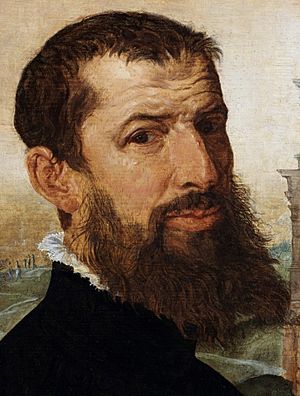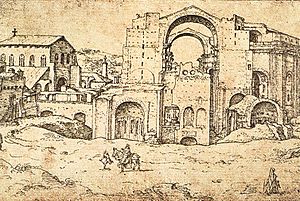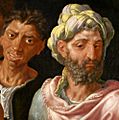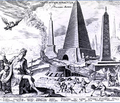Martin van Heemskerck facts for kids
Marten van Heemskerck (born 1498, died 1574) was a famous Dutch painter from the 1500s. He was known for his portraits and religious paintings. He also became very famous for a series of colourful pictures he made of the Seven Wonders of the World.
Contents
Early Life and Learning to Paint
Marten van Heemskerck was born in a town called Heemskerck, near Haarlem in Holland. His dad was a farmer. Marten started learning to paint with two different teachers in Haarlem. But his dad called him home to help on the farm.
Marten really wanted to be a painter, so he ran away from home. He traveled 50 miles in one day to the town of Delft. There, he found another teacher to learn painting from. But he soon left that teacher too. After that, he went to Haarlem. From 1527 to 1529, he worked with a painter named Jan van Scorel.
Travels and Inspiration in Italy
One artist who really inspired Marten van Heemskerck was Jan Mabuse. Mabuse had traveled to Italy and seen amazing paintings by famous artists from Florence and Venice. Marten started to copy Mabuse's painting style.
In 1532, Marten went to Italy himself. He spent several years traveling from town to town. He looked at many artworks and drew everything he saw.
Rome and Ancient Ruins
The city that had the biggest impact on Marten van Heemskerck was Rome. He was very interested in the old ruins left from the time of the Ancient Romans. He made many drawings of the ruined buildings and other things he saw.
His sketchbooks are now in a museum in Berlin. They are very important because they show us what Rome looked like in the 1500s. One important building he drew was St. Peter's Basilica. It had been started but was not yet finished.
Inspired by Michelangelo
The most famous artist alive at this time was Michelangelo. He was mostly a sculptor. But he had spent five years painting the ceiling of the Sistine Chapel. Marten van Heemskerck, like everyone else, thought it was incredible.
He was so inspired by the figures Michelangelo painted. He designed a series of pictures called "Twelve Panels showing Strong Men from Mythology and Biblical History." These, like his "Seven Wonders of the Ancient World" series, became well-known. They were sold as "prints" made from "engravings." Engravings are pictures printed from a metal plate with the design cut into it.
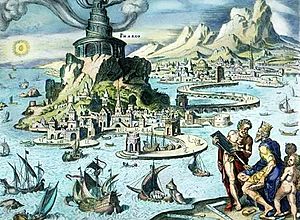
Working as a Scene Painter
In 1536, while in Rome, van Heemskerck got a job as a "scene-painter." This is like someone who paints the scenery for a theatre play. Charles V was coming to Rome for a "triumphal procession." This was a big parade to celebrate him.
The city streets were decorated with archways for the emperor to walk under. Van Heemskerck worked with other artists like Antonio da San Gallo. A writer named Giorgio Vasari saw some battle scenes Marten painted. Vasari wrote that they were well put together and painted boldly.
Later Life and Legacy
Marten van Heemskerck returned to the Netherlands and lived in Haarlem. He settled down and got married twice. After that, he only left Haarlem for a short time in 1572. He went to Amsterdam because the Spanish army had attacked Haarlem.
In 1540, he became the president of his Guild of Painters. This was a group for artists. He became a rich and well-known painter. When he died, he left some money in his will. This money was to be given to a new bride and groom who would get married on his tomb. People believed this custom would bring peace to the dead person. He also left some land to help an orphanage in the city.
Many of Marten van Heemskerck's artworks can still be seen today. These include "Adam and Eve" and "St. Luke painting the Madonna and Child." There is also a painting of Jesus in a museum in Ghent, Belgium. These pictures were made before he went to Italy. In the 1550s, he painted several altarpieces. These can be seen in museums in Delft, Haarlem, and Brussels. He also painted scenes from the lives of St. Bernard and St. Benedict.
More Information
- The article is available here .
- Diana Davies (editor), "Harrap's Dictionary of Art and Artists", Harrap (1990) ISBN: 0245546928
- Ilan Rachum, "The Renaissance, an Illustrated Encyclopedia", Octopus, (1979) ISBN: 0706408578
Images for kids
-
Detail of Ecce Homo Altarpiece (1544), National Museum, Warsaw. This shows Heemskerck's style with strong figures.
-
Painting by van Heemskerck showing the abduction of Helen, queen of the Greek city-state Sparta, by Paris. The Walters Art Museum
-
Colossus of Rhodes, imagined in a 16th-century engraving by Martin Heemskerck
-
Hanging Gardens of Babylon, an early imaginary picture based on old descriptions.
-
The Temple of Artemis, shown with an "old-fashioned" look.
-
A made-up picture of Phidias' Statue of Zeus at Olympia, from a drawing by Heemskerck.
-
An imagined picture of the Mausoleum at Halicarnassus, 1572.
See also
 In Spanish: Maarten van Heemskerck para niños
In Spanish: Maarten van Heemskerck para niños


